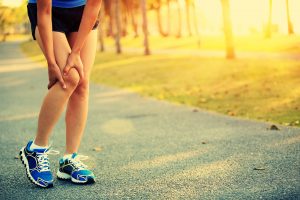PFPS, Patellofemoral Pain Syndrome (Runners Knee)

Runners, jumpers, and other athletes such as skiers, cyclists, and soccer players put heavy stress on their knees. Runner’s knee is a term used to refer to a number of medical conditions that cause pain around the front of the knee (patellofemoral pain). These conditions include anterior knee pain syndrome, patellofemoral malalignment, and chondromalacia patella.
What is PFPS (Patellofemoral pain syndrome)?
Patellofemoral Pain Syndrome, PFPS for short, or also known as Runner’s knee or Jumpers knee. Is a overuse condition that causes inflammation to the knee joint that results in pain for the patient. Runners, jumpers, and other athletes such as skiers, cyclists, and soccer players put heavy stress on their knees and bodies for that matter. Runner’s knee is a term used to refer to a number of medical conditions that cause pain around the front of the knee (patellofemoral pain). These conditions include anterior knee pain syndrome, patellofemoral malalignment, and chondromalacia patella. This condition is similar to shin splints in method of cause, but in this case the irritation is just higher up the leg.
PFPS (Patellofemoral pain syndrome) Symptoms
The main symptom of PFPS is pain. Pain while bending the knee while kneeling, or squatting. Pain while having the knee bent for long periods of time, such as driving in the car, or sitting at a desk. The pain will be dull and ache, gradually becoming stronger as the condition progresses over time. The pain will feel like it is presenting at the front of the knee; to be exact it will present in the connective tissue between the patella and the femur. The patient may also hear some symptoms such as cracking and popping when stepping up or down, for example, using the stairs.
Causes of PFPS (Patellofemoral pain syndrome)
PFPS being an overuse condition can have many causes. The joint could simply be used more than normal and beyond the capacity of use that the knee is ready to handle. Impact can be a cause as well such as use on a hard surface passing along the jarring energy to the knee joint. A pair of new shoes, or a pair of ill-fitting shoes could slightly change the body mechanics distribution of energy to the knee causing mal-alignment irritation. PFPS could be caused by genetic variation, knee cap alignment, patellar tracking, or carrying too much weight. Also, weak muscles around the knee or unbalanced muscles could cause stability issues leading to inflammation as well. All of these possible causes really come down to the same concepts of overuse, or misuse due to mal-alignment, of the knee joint.
Patellofemoral pain may be the result of irritation of the soft tissues around the front of the knee. Strained tendons are fairly common in athletes. Other contributing factors to patellofemoral pain include overuse, muscle imbalance and inadequate stretching. Pain that begins in another part of the body, such as the back or hip, may cause pain in the knee (referred pain).
In some people with runner’s knee, the kneecap is out of alignment. If so, vigorous activities can cause excessive stress and wear on the cartilage of the kneecap. This can lead to softening and breakdown of the cartilage on the patella (chondromalacia patella) and cause pain in the underlying bone and irritation of the joint lining.
The knee is a complex structure and is very sensitive. A number of factors can contribute to runner’s knee, including:
Malalignment of the kneecap
Complete or partial dislocation
Injury
Excessive training or overuse
Tightness, imbalance, or weakness of thigh muscles
Prevention of PFPS (Patellofemoral pain syndrome)
Prevention of PFPS is as simple as preventing the causes. Make sure your shoes fit well. Stretch before exercising. Make sure you are balancing the exercise on your legs; don’t just work your quads and forget your hamstrings. Be mindful on the surfaces you exercise and walk on making sure to avoid hard surfaces. Use proper technique when exercising or playing sports to ensure correct alignment. Keep your body health and at a proper weight. If you are going to do one thing to stay out of the orthopedist’s office it should be to lose weight. Also, pace yourself, whether you are an athlete or just getting started, do not push your body to much and aim for slow and steady improvement over time.
Treating PFPS (Patellofemoral pain syndrome)
Treatment will begin R.I.C.E. (Rest, Ice, Compression, Elevation) and NSAIDs can be used for the pain and inflammation. Failure to eliminate the knee pain after rest and over the counter pain relief will point to the possibility of malalignment. Therapy will be recommended to try and rebalance the muscles in the leg that support the knee. Strengthening and balancing the leg muscles will keep the knee in proper position and can help relieve the symptoms. Supportive braces, or athletic tape, can be used to keep the knee in place during rehabilitation to reduce re-injury. Icing the knee after exercise can also be helpful in reducing inflammation. If nothing is helping than avoidance of irritants can be considered as well as surgical intervention. If surgery is to be considered a sports medicine physician may suggest removing fragments of damaged cartilage arthroscopically, or they may suggest surgical correction of the patellar alignment.
For Orthopedic care near you call 817-375-5200

